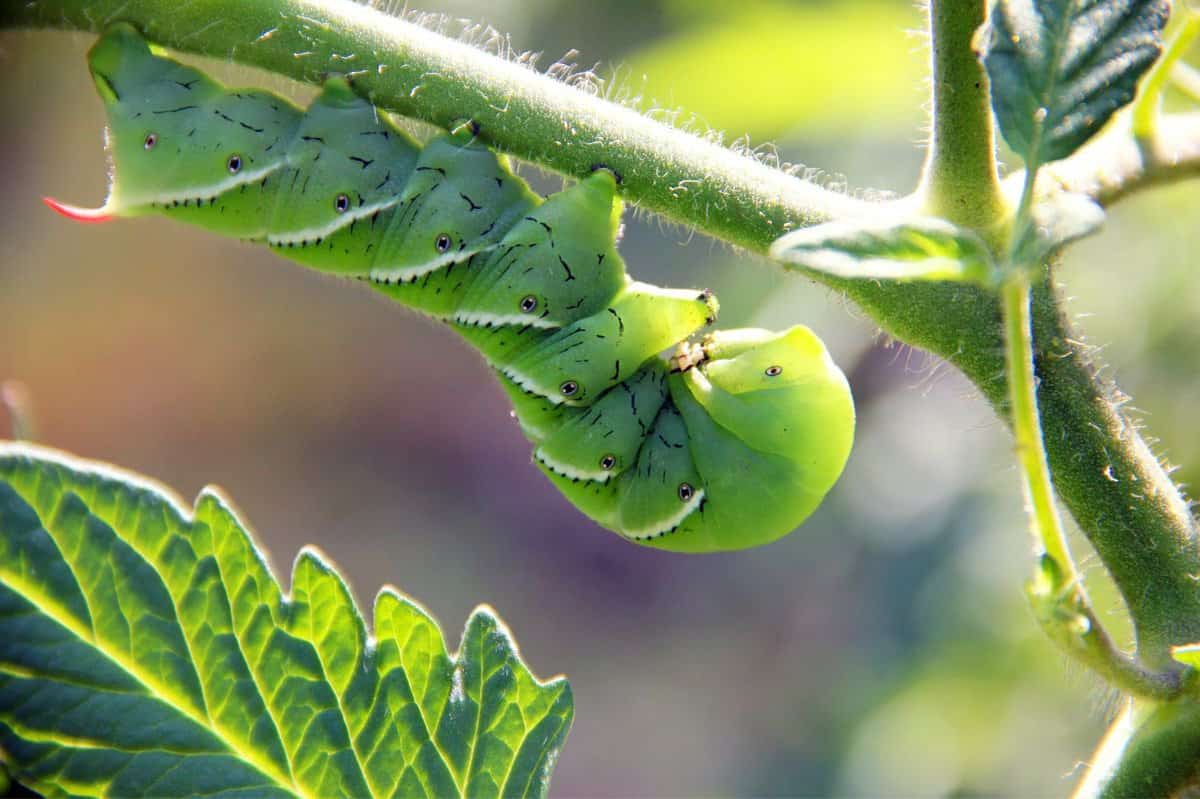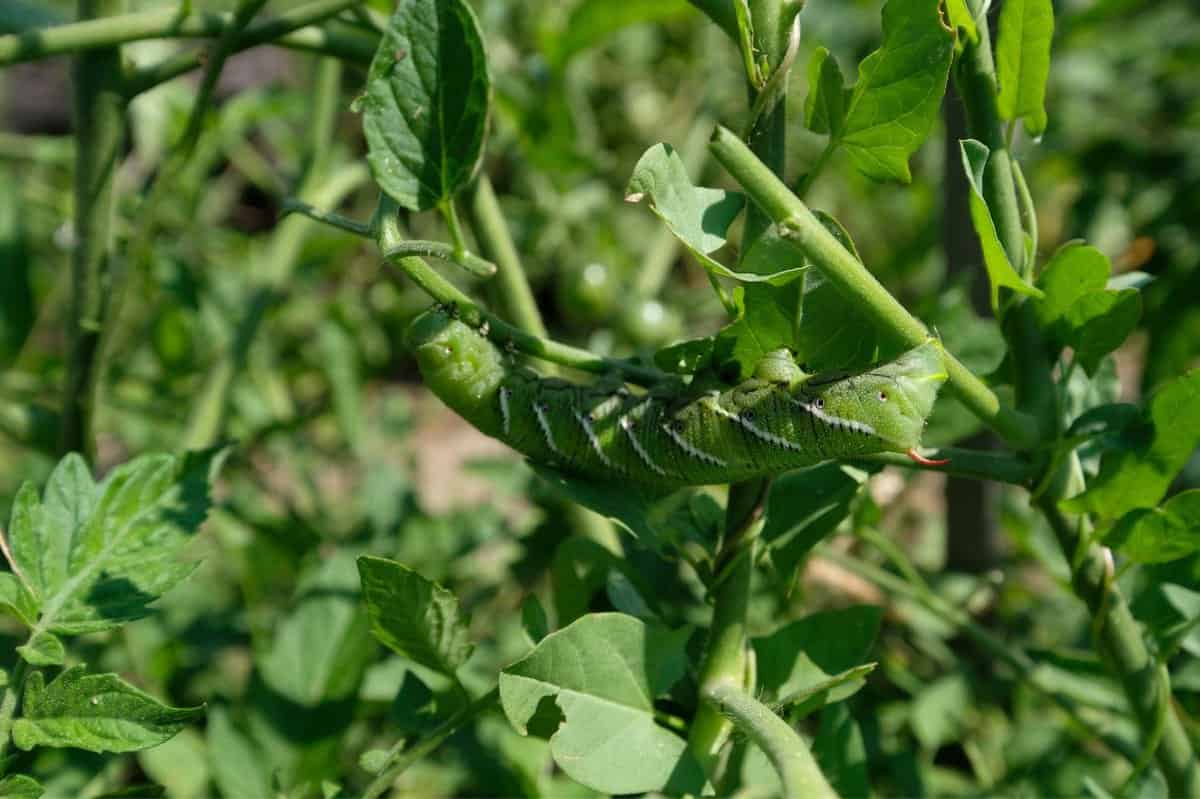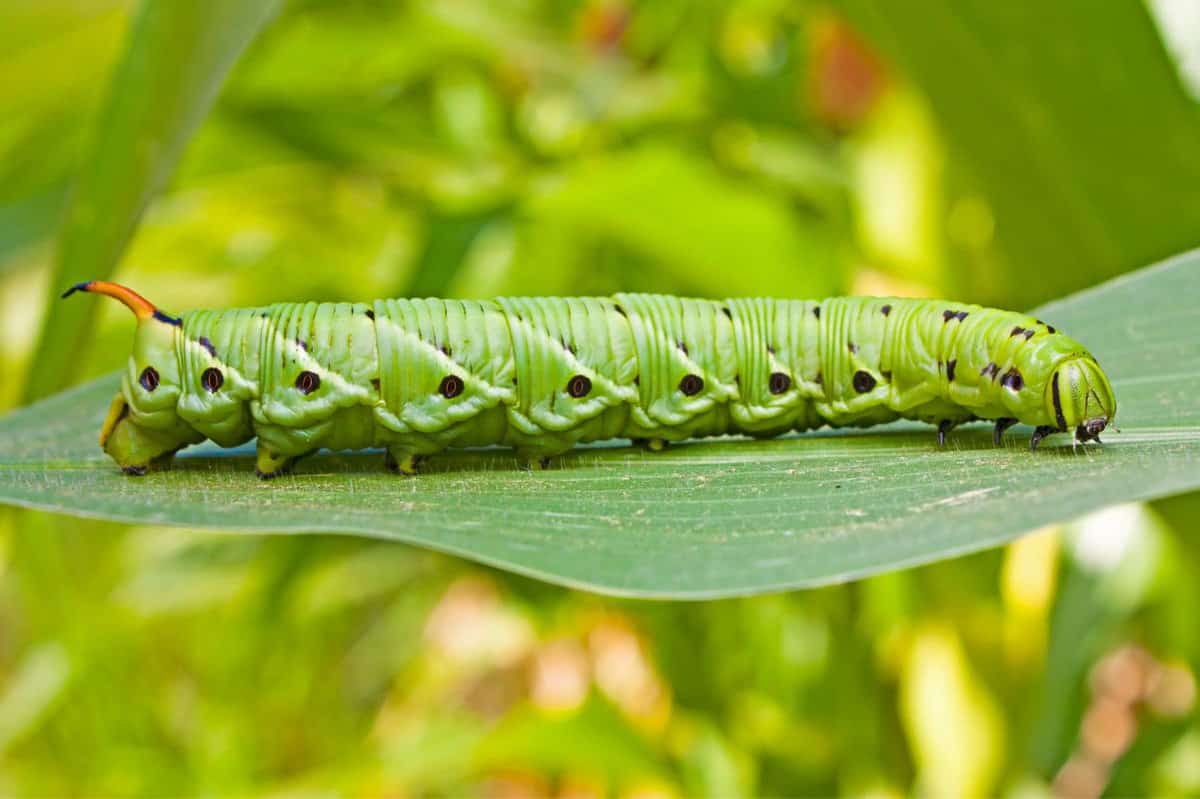If you grow tomatoes, chances are, you’ve stumbled upon tomato hornworms. These big, fat green caterpillars might look cute and unassuming, but they will destroy an entire tomato plant in a matter of hours! Luckily, they are easy to spot and easy to manage—so don’t worry too much if you see one of these chubby fellows chewing on your plants. We’ll show you how to handle it!

Table of Contents
What are hornworms?
Hornworms are massive green caterpillars. They are bright green and can get up to three or four inches long. They get their name from the spikes on their rears.
There are two types of hornworms that you are most likely to see in home gardens: tomato hornworms (Manduca quinquemaculata) and tobacco hornworms (Manduca sexta). Tobacco hornworms have black horns and pale yellow V’s on their bodies, while tomato hornworms have reddish horns and diagonal white stripes. Both can be found throughout North America, though tobacco hornworms are more likely to be found in the southern states. And both can do lots of damage to your tomato plants!
In our garden, they start to show up about mid-summer, and we’ll continue to see them pop in for the next few months.
How to identify hornworms
You are most likely to see these insects on tomato plants, but they will also munch on other plants in the nightshade family (solanaceae), such as potatoes, eggplants, and peppers. Their large size and bright green color make them easy to distinguish from other pests.
The one hiccup here is that hornworms are almost the same green color as a healthy, vibrant tomato plant. So they are pretty good at camouflage! But their path of destruction gives them away. If you see large swaths of your tomato plants that suddenly (we’re talking overnight or within a few hours) look like all the leaves have been eaten away, put on your specs and start searching for hornworms.

What do tomato hornworms turn into?
Hornworms turn into spotted moths commonly referred to as hawk moths, sphinx moths, or even hummingbird moths.
Damage caused by tomato hornworms
Tomato and tobacco moths can make quick work of a tomato plant, eating entire leaves. They also may eat the developing tomatoes. Eventually, the entire plant will get eaten down to the ground. So if you see a hornworm on your nightshade plants, it is important to remove them quickly!

Are they poisonous?
Nope, they are generally not considered poisonous to humans, and they cannot sting.
Will tomato plants recover from hornworm?
Absolutely! In our experience, a hornworm infestation is rarely more than just a handful of big hornworms that are easy to pick off, so even if they do eat a significant portion of the plant, it’s easy to control the worms and give the plant a chance to recover. Once we’ve removed hornworms from the plant, we like to give our tomatoes a little extra boost of organic fertilizer (we like the combo of diluted fish emulsion and liquid kelp) to help it regrow that lost foliage.

How to get rid of tomato hornworms
The simplest, most effective way to manage these pests is to hand-pick them off the plants. You can pick off the hornworms themselves, or if that gives you the heebie-jeebies, just snip off the small branch that the worm is on. Drop them in a bucket of soapy water to kill them, or—and this is what we do—feed them to your chickens!
In our experience, large infestations of hornworms are rare, but if you do have one, diatomaceous earth (DE) is a great choice. Sprinkle this powder onto your tomato plants when dry, and the worms crawl through it and eventually die because the DE cuts the soft bodies of the insects. You’ll need to reapply if the DE gets wet. DE is non-toxic, all-natural, and safe to use outdoors around humans and pets—although it can be fatal to any soft-bodied insect.
Growfully Protip
If you see a hornworm with what looks like grains of white rice on its back—leave it be! These are the cocoons of parasitic braconid wasps. Not only will those wasps eventually hatch and kill that hornworm, but they will also be a great beneficial insect addition to your garden. Anything you can do to increase their population is a good thing!

How to protect your plants from tomato hornworms
There are a few steps you can take to prevent a hornworm infestation in your home garden:
- Crop rotation is vital, as hornworms overwinter beneath the soil.
- Attract wasps. Small wasps known as braconid wasps are parasitic to hornworms. The wasp larvae form white cocoons on the back of the worm that look like grains of rice. Eventually, wasps will emerge from their cocoons and kill the hornworm. Attract beneficial insects by planting a pollinator garden.
- Companion plants such as basil, borage, dill, and marigolds will help to repel these pests.
- Attract birds and other small animals that will prey on hornworms.







